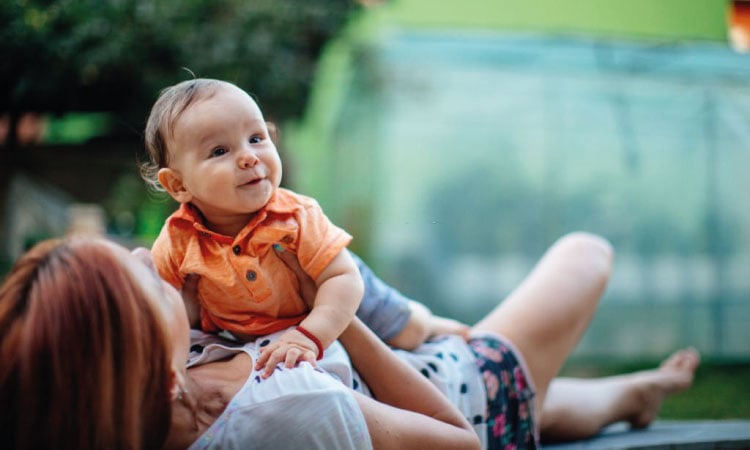Being a parent means taking care of and understanding your baby. You must cater to the specific needs of infants throughout the entire development process. Apart from diaper changing and feeding, parents need to understand many possible things that may happen to the baby during their first few months of life. Our article will provide an overview of what the startle reflex in new-borns is and how you can control the startle reflex in new-born without any difficulty.
Reflex In Babies
Involuntary actions or movements are known as reflexes. New-born reflexes are a vital part of a baby’s survival, and they are a very normal part of the development process. The reflexes of the babies tell us whether their nervous system and brain are functioning properly. A new-born’s reflex is an involuntary movement or a neurological response to an external trigger. New-borns exhibit a number of inborn reflexes, including, startle reflex, rooting, sucking, plantar grasp, Palmer grasp, and tonic neck reflex. Babies are born with several reflexes. The majority of these inborn reflexes that are vital for the survival of new-borns will disappear during the first year of the baby’s life.
What Is Startle Reflex In Babies?
Infants develop an involuntary motor response referred to as the startle reflex shortly after birth. In fact, doctors often check for startle reflex in new-borns because it’s a sign the nervous system is functioning properly. The startle reflex occurs when a new-born baby is startled. Any unexpected loud sound or movement can trigger this reflex.
A baby reacts to the trigger by throwing their head back, extending their arms and legs, wailing, and then pulling the arms and legs in. Even a baby’s own cry can catch them off guard and trigger this reflex! The reflex lasts for about two to three months after the baby is born. The severity of the startle reflex, also known as Moro reflex, determines whether a baby cries.
Related Reading: 12 Home Remedies To Ease Your Baby’s Vaccination Pain
What Causes Startle Reflex In New-Borns?

A new-born is unfamiliar with virtually everything, so he or she is easily surprised and even scared by new sounds and sensations. Some of the things that can trigger the startle reflex in babies include:
Unexpected movements: It is possible for babies to feel like they are about to fall if they experience unexpected movements. Unanticipated movements can trigger startle reflexes in babies. Among these movements are:
- The movement of placing the baby in his bassinet without enough support
- Picking up the baby suddenly from the bed
- Shifting its head into a different position
Unexpected sounds: Sudden, loud sounds (it may not be loud enough to startle an adult) from nearby can startle the baby. Any sound from the sound of a mobile ring and door closing to the barking of a dog, to the wailing of an ambulance, or something dropping and crashing to the ground can trigger a startle reflex in babies.
Very bright lights: Switching on a bright light in a dimly lit room can startle the baby. In the same way, taking your baby to a very bright light source, especially after he or she has been in a dark or dim environment, can trigger a startle reflex.
There are times when there is no apparent reason why a baby will exhibit a startle reflex. Dreams of falling, for example, can trigger a baby’s startle reflex while sleeping.
Startle reflexes play a role in waking up new-borns, which can result in them having a hard time settling back down again (and possibly crying a lot). This is one of the downsides of the startle reflex in babies. Often, however, babies are not bothered by this at all and go back to sleep as if nothing had happened.
Related Reading: 8 Cues Of A Tired Baby
How Long Does The Startle Reflex In Babies Last?
Startle reflexes are present in full-term babies at birth. Babies may exhibit the full startle reflex in the first 12 weeks following birth, which includes the legs, arms, and head. When the neck is capable of supporting the head’s weight, which occurs when the baby is at about four months of age1, the startle reflexes become less intense and less frequent.
With time, the reflex begins to fade, and the baby may only stretch and curl his arms, but won’t move his head or legs. While every baby’s startle reflex is different, most parents notice their little one’s startle reflex peaks in the first month, gradually fades in the second and third months, and disappears completely by the sixth month2. By this time, they’ll be able to control their movements better, and their reflexes will be more controlled.
Is It Possible For The New-Born Not To Be Displaying Startle Reflex?
In preterm infants, the startle reflex is particularly weak, as their muscle tone is lower, their resistance to passive movements is low, and their arm recoils are slower than those of full-term babies of the same developmental stage. Some new-borns, on the other hand, fail to display a startle reflex. The absence of the Moro reflex during the neonatal period and early infancy can be clinically significant. This might suggest various compromised conditions3.
Related Reading: 18 Baby Proofing Ideas To Ensure There Are No Accidents
Startle Reflex In Preemies
If your baby is a preemie, keep in mind that the timing of their startle reflex may be different from that of full-term babies. There can be a delay in the onset of the reflex, and the reflex may linger longer than it is expected to. The difference between your baby’s birth date and developmental age accounts for this.
How To Reduce Startle Reflex In Infants?

There’s a reason Mother Nature included the startle reflex with the rest of the primitive reactions babies are born with. So, we can’t completely get rid of it. Also, after a few months, the startle reflex will begin to fade on its own as your baby becomes more familiar with the world and its nervous system matures.
However, in case the baby’s startle reflex gets worse, you can take the following steps to prevent your child from startling awake:
Keep your baby close to you: Babies have a tendency to startle when you move them suddenly. As you try to put your sleeping baby into the crib, you might notice their startle reflex. Laying your baby down while leaning over could cause your baby to feel as if they are falling. Even if your baby is sleeping soundly, a startled reflex could wake them up. Therefore, make sure you pick up and put down your baby gently, and make sure you support his neck and head with your hand. When your baby’s back is on the mattress, gently release him. In this way, they should be able to avoid experiencing a falling sensation, which can trigger their startle reflex.
Swaddling can be helpful: Swaddling involves wrapping up your baby in a blanket systematically. It is a good way to make them feel safe and secure. ‘Swaddling’ mimics the tight, coziness of the womb. Your child will also sleep longer when swaddled.
A swaddle that is tight enough helps to keep his arms and legs from jerking. Thus, through the startle reflex, the baby will sleep better. The hospital or online may have swaddle tutorials, or you can buy a blanket with Velcro tabs that make swaddling easier.
Make sure that sudden changes in the brightness of light or sound don’t disturb your baby. The mobile phone should be muted and doors and cupboards should be opened and closed with caution.
What If The Baby Shows Exaggerated Moro/Startle Reflex?
Even though the startle reflex is a good sign for new-borns, some babies have an overactive Moro reflex. An exaggerated startle reflex in new-borns can not only interfere with sleep but can also be a sign of hyperekplexia, an inherited neurological condition. According to source, exaggerated startle reflexes accompanied by a brief time when the child is unable to move is one of the main characteristics of hereditary hyperekplexia, which is an acquired nervous system disorder.
When To Consult A Doctor?
A baby can have potential problems if their reflexes do not function normally. The lack of startle reflex can be an issue. A broken shoulder or a birth injury can result in the lack of startle reflex on one side of your baby’s body. Another possibility is spastic cerebral palsy, a neurological condition. If the startle reflex is absent on both sides, it might indicate brain or spinal cord damage.
If you have not noticed the startle reflex in your baby, do not become alarmed. During your baby’s checkup, your baby’s doctor will be able to determine whether the startle reflex is present and normal. Your baby’s doctor may recommend further testing to examine the baby’s muscle and nerve function if he has any concerns.
The same is true if your older child is still showing the Moro reflex well beyond the six-month mark. In such cases, there may be a more serious issue at hand. Make an appointment with your pediatrician, who will be able to perform a test to determine what the problem is.
Conclusion

Each baby has a different degree of the startle reflex. It may feel strange to you at first until you get used to it, but it doesn’t affect your baby at all and is an indication that he is healthy and developing as he should. Startle reflex is your new-born’s first attempt to protect himself and gain a sense of balance.
FAQs
There is no need to worry if your baby doesn’t startle whenever loud noise is made or bright light is seen.
However, if a child does not have any Moro reflex at all, there may be an underlying medical condition.
After four months, if your baby still has the Moro reflex, you should consult his healthcare provider. It could indicate developmental delays.
Based on various other assessments and tests, your healthcare provider will evaluate your baby’s case.
![[GetPaidStock.com]-62a2dc00e38c9 Startle Reflex In New-Borns](https://parenting.miniklub.in/wp-content/uploads/2022/05/GetPaidStock.com-62a2dc00e38c9.jpg)
